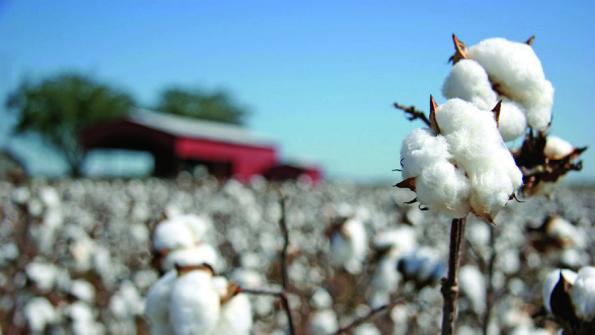
In a year when cotton growers will be squeezing pennies wherever possible in their production budgets, two of the best decisions they can make toward achieving a profitable crop are variety selection and variety management, says Darrin Dodds, Mississippi State University Extension cotton specialist.

DARRIN DODDS
Although cotton prices were only about 61 cents the first week in February, indications were that the state’s growers will be increasing acres this year, he said at the annual meeting of the Mississippi Agricultural Economics Association. “Everyone I talk to is increasing cotton acreage to some degree. The USDA planting intentions report indicates that cotton acres in Mississippi could increase as much as 40 percent. What’s really interesting is that, with prices at this level, more cotton is expected.”
With the outstanding varieties available today, there is potential for high yield, Dodds says. But achieving that potential requires careful variety choice and careful management of those varieties.
“When I put a pencil to it, in the Delta, where growers water hard, fight plant bugs, and have other challenges, it’s probably going to take 1,100 to 1,150 pounds to break even — 1,000 pounds just won’t cut it in the Delta any more. In the hills, where insect control is still fairly manageable, 825 pounds will probably be feasible.”
IT’S FREE! Stay informed on what’s happening in Mid-South agriculture: Subscribe to Delta Farm Press Daily.
In MSU trials replicated at 17 on-farm locations last year, the highest yield was 1,345 pounds; the mid-level yield was 1,213 pounds; and the lowest yield was 1,127 pounds. Using a 65-cent lint price and a $55 per bale gin rebate, Dodds says, the best yielding variety would gross $1,028.36; the mid-yielding variety, $927.44; and the lowest yielding variety, $911.69.
“There’s almost $120 per acre difference between the high yield and low yield that’s solely attributable to variety choice,” he says. “If you, as a consultant, tell your grower he can potentially make an extra $120 per acre just by selecting the right variety, you’ve instantly paid for your services, and given the grower a nice profit.”
Much better varieties today
In the 1997-2015 period that Dodds refers to as “the era of technology,” there has been, with a couple of exceptions, an upward yield trend for cotton, he says. “Since 2007 and all the acreage reductions that have occurred, growers have been putting cotton on their better ground. But a big factor in the yield increases is that varieties have gotten much better — we have some really, really good choices of cotton varieties today.

Justin George, left, J.P. George Consulting Service, Merigold, Miss., and president of the Mississippi Agricultural Consultants Association, visits with Phillip McKibben, McKibben Ag Services, Maben, Miss.
“Almost every year for the past five years, we’ve seen a bump in yields, with a state average ranging from 950 pounds to over 1,000 pounds. Even in 2015, when areas like Tchula, Miss., didn’t see rain from July 4 through harvest, we still had a state average of more than 1,000 pounds — which is exceptional. With today’s price, we need to make as much cotton as we can to pay for the inputs.”
Dodds says there’s “an overriding sense this year that everyone is going to tighten the rein on expenses. In my mind, with economic times as they are, consultants can have the most impact by working with growers to be sure they make cuts where they can afford to make them, and not make cuts where they can’t afford to.”
One place that can make a difference, he says, is fertility. “When farmers are searching for ways to make cuts, this is one of the first places they look. But as I’ve said many times: You can go a long way with adequate fertility, but you won’t go very far without it.
“You may save a little money now by cutting back, but you’re potentially paying a lot of money down the road when you have to build fertility levels back up. If you’re soil testing in a high to very high fertility range, and you want to cut back a bit, I can probably go with that — but at least make maintenance applications of fertilizer to replace what is being removed by the crop.”
“If you’re making 1,500 pound cotton, the crop is taking up 155 pounds of K20 in the seed, lint, burs, stalks, and leaves, with other sources indicating as much as 200 to 210 pounds. For a maintenance application, I’d recommend 90 pounds of actual K, or 150 pounds of potash. With 62 cent cotton, I know a grower may not want to do this, but again, you can pay a little now, or you can pay a lot later.”
Good root system is critical

"If you don’t have a good root system under the cotton plant, it doesn’t matter how good the variety is, it won’t perform to its potential," says Darrin Dodds.
It’s also important, Dodds says, to pay attention to pH, “which a lot of times seems to be forgotten. If you don’t have a good root system under that cotton plant, it doesn’t matter how good the variety is, it won’t perform to its potential. We saw a lot of instances last year of cotton that was shallow-rooted because of pH issues and excessive rainfall. Then when it turned off hot and dry, that was the first cotton to go down the tubes because it didn’t have a root system deep enough to provide the water the plant needed.”
Managing plant bugs will continue to be a challenge for many growers, especially in the Delta, where they’ve been “very troublesome,” Dodds says. A collaborative effort is under way by Dodds, Angus Catchot, Jeff Gore, Don Cook, and others to determine what can be done to minimize the impact of plant bugs through cultural practices.
“Some of the things you can do: Block corn and cotton separately, if you can. Plant as early as weather will allow, which hasn’t been easy the last two or three years. Plant an early maturing variety early in the year, which may help you to limit the number of plant bug applications later in the year.”
Pubescent varieties can also be a factor in limiting plant bugs, he says, but they can, in some cases, cause grade problems in ginning due to trash. “The last thing you want is to pick a 1,600 or 1,700 pound crop and then get a 6 or 7 leaf grade. But if your gin can adequately clean the lint, there appears to be some merit in using hairy-leaf varieties to help minimize plant bugs.”
Other management practices for high yields, Dodds says, include an application of Diamond insecticide, and optimum nitrogen rates. “I still like 80 pounds to 90 pounds of N, especially on silt loam cotton land, or where you’re following peanuts or corn with cotton.”
Pay heed to variety management
Variety management is “something I feel strongly about,” he says. “We have a lot of performance data from a lot of sources, but I think we’re still lacking a complete program of variety management — where to put a variety, how to irrigate it, how to use growth regulators, resistance or susceptibility to bacterial blight, choosing the best seed treatment for your money, and others. It’s further complicated by the fact that a good variety may be available for only four or five years, and by the time we get all the management factors figured out, that variety has been replaced.”
Money spent on weed and insect control is “money well spent,” Dodds says. “But I believe the high cost of cotton weed and insect control has been as much responsible for the loss of acres as price. Sixty-two-cent cotton isn’t a bed of roses, but having to spend $100 per acre to kill insects and $100 to control weeds certainly hasn’t done cotton any favors either.”

“62-cent cotton is going to make us change what we’re doing — it’s going to make us modify our programs in order to make the most money we can from the crop," Darrin Dodds told Mississippi consultants.
And, he says, “62-cent cotton is going to make us change what we’re doing — it’s going to make us modify our programs in order to make the most money we can from the crop.
“If you’re looking to make cuts in your cotton budget, it’s OK to do that, but make the cuts in appropriate places. If you’re testing in the high to very high range on some of your fertility, you may consider making a maintenance application of fertilizer as opposed to build-up applications. But I wouldn’t totally eliminate fertility, especially potash, knowing that a high yield cotton crop is going to pull out almost 100 pounds of potash.
“If potash doubles in price next year — and we never know what the price is going to do — you can save some money by not applying it this year, but you’ll spend a lot more money next year to replenish what you’ve taken out. Applying lime is not inexpensive, but if you don’t have a good root system under your crop, you’re behind the 8-ball from the get-go.”
Dodds advises consultants to “encourage your growers to spend money on products they know are going to pay the bills at harvest time.” And, he says, “keep an open mind, and be willing to change and adapt.”
About the Author(s)
You May Also Like




